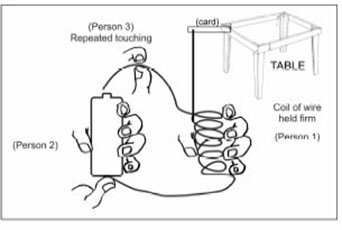Resource 4: Workcards
 Teacher resource for planning or adapting to use with pupils
Teacher resource for planning or adapting to use with pupils
WORKCARD 1: HEAT What you have: - a torch cell/a torch bulb
- a 10 cm length of very very thin, bare wire (unravelled from wire flex from an old broken tape recorder) or fuse wire
- a 10 cm length of ordinary bare copper wire
What you do: |
 | - Hold the 10 cm wire with the two ends on the top and bottom of the torch cell.
- Touch the arc of the wire to the back of someone’s hand. Do they feel anything?
- Repeat using the length of very very thin wire/or fuse wire. Do they feel anything now?
- What form of energy do you sense here?
- Discuss what you have felt. Try to think of an explanation of your own. Experiment using the different wires to light the bulb. Compare the brightness. What do you think?
|
WORKCARD 2: MAGNETISM What you have: - a torch cell
- a 30 cm length of insulated copper wire
- a large soft iron nail
- some metal objects – pins, tacks, etc.
- iron filings
- a small compass
What you do: |
 | - First check to see if the large soft iron nail has any effect on the pins, tacks, iron filings and compass.
- Wrap the wire around the large soft iron nail many times.
- Hold the two bare ends against the terminals of the torch cell.
- While it is still attached, check to see the effect on the pins, tacks, etc.
- What form of energy do you find?
- Can you get one end of the nail to ‘repel’ (push away) one end of the compass?
- What is your group’s explanation of what you see here?
|
| WORKCARD 3: MOVEMENT What you have: - a torch cell
- 25 cm length of insulated copper wire
- a steel needle or pin that has been magnetised (made into a magnet) by being placed alongside a strong magnet for a time
- a 15 cm strip of thin, flexible card
- a small electric motor from an old broken toy or tape recorder
- a drawing pin
What you do: |
 | - Make a tight coil by wrapping the wire around a pencil.
- Fasten the strip of card to the edge of the table/desk so that it is like a swimming pool diving board.
- Push the magnetised needle so that it hangs vertically from the end of the strip.
- Hold the coil steady with the magnetised needle dangling into the centre of the coil.
- Hold the torch cell with one bare end of the wire from the coil in contact with the base.
- Another person repeatedly touches the other end of the wire to the top of the cell.
- Discuss what you have seen happen. What form of energy do you find? What is your group’s explanation for what you have seen?
- Now turn the torch cell upside down and repeat the activity. But first PREDICT what you think you will see.
- Finally – use the torch cell to work the small electric motor. What direction is it spinning? Can you reverse the direction?
- Do you think an electric motor might have something to do with coils of insulated wire and magnets?
|
WORKCARD 4: SOUND What you have: - a torch cell
- small speakers from old broken electrical equipment
- grains of coarse sand/bits of wire flex
What you do: |
- Experiment to see if you can get sounds from the speakers by attaching the torch cell to the speaker terminals (why are there always two?).
- You should be able to get a crackling sound.
- What do you have to do to repeat the sound?
- Sprinkle grains of coarse dry sand onto the open cone of the speaker. What do you notice as you make repeated crackling sounds?
- Look carefully at the speakers. Can you see any arrangement of magnets and coils or spirals of wire?
- Discuss your own ideas of how a speaker works.
- Can you link your ideas to Workcard 3: Movement?
|
WORKCARD 5: LIGHT What you have: - three torch cells
- four torch bulbs
- assorted lengths of flex wire
You have already seen how we get a bulb to light and you have already investigated the structure of a light bulb. What you do: |
- Investigate different arrangements for getting different numbers of torch cells to light up different numbers of bulbs.
- Record the different arrangements that work. Draw pictures to show these.
- Which were the brightest bulbs?
- Can you think of ways to explain what you see?
|
![]() Teacher resource for planning or adapting to use with pupils
Teacher resource for planning or adapting to use with pupils





